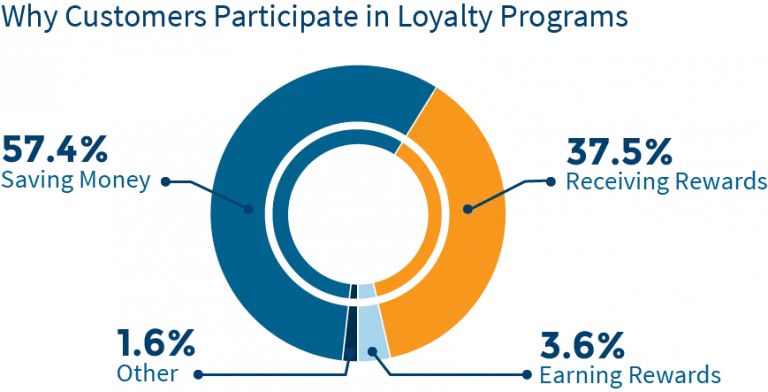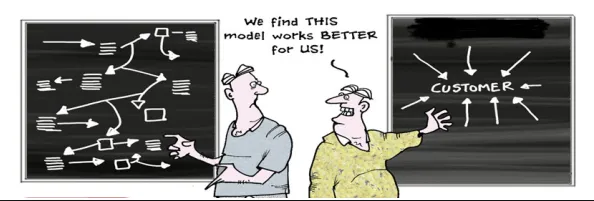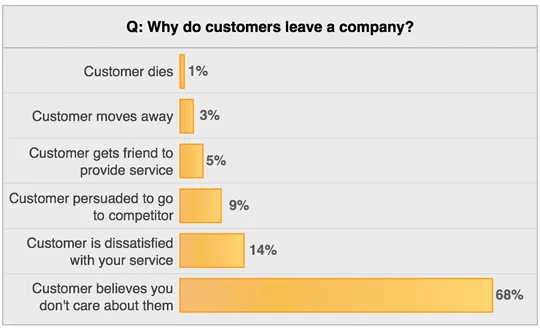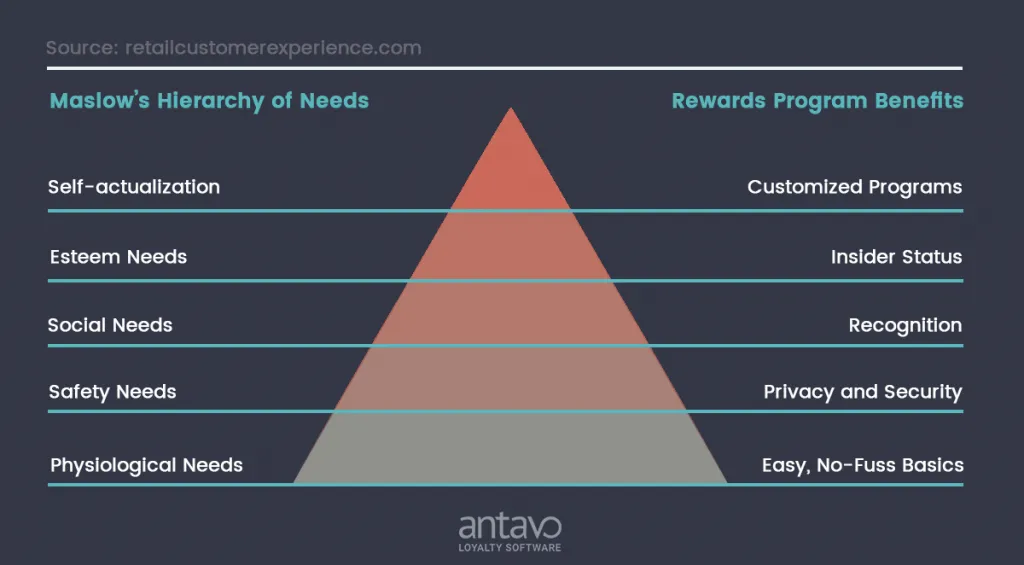What Customers Want from Your Loyalty Program
The average consumer is enrolled in 13.4 loyalty programs, but only active in half of them.
Why? Too many loyalty programs are built without prioritizing the customers’ needs.
When there’s no clear value advertised to the customer, there’s no reason for them to participate.
The whole point of a loyalty program is to acquire customers, retain them, and increase their lifetime value with your brand, but this is only possible if customers feel you are benefitting them in a way that a competitor isn’t.
Your best chance at success starts with understanding what your customers want, and how you can deliver on those needs to provide consistent value.
We turn to modern customer loyalty data to help you understand today’s customer expectations, plus methods for how you can pinpoint exactly what YOUR customers want.
What your customers want from a loyalty program
Cost Savings: The main source of program participation
Research by Technology Advice states that “saving money” is the primary reason why customers participate in loyalty programs (answered by 57.4% of respondents).
This data was pulled from surveying 3,162 loyalty program members across the US.
Rewards that play to a customer’s financial needs are the most well-known form of loyalty rewards, as their ubiquity appeals to the broadest range of users.
In fact, one of the earliest loyalty programs from the 18th century involved giving users copper tokens that they could redeem for future purchases. It’s a tried and true strategy that has survived centuries of business evolution.
In the modern economy, many brands see success by offering store credit, discounts, or points redeemable for future cost savings, like The North Face's points program pictured below. It’s a great way to provide instant gratification and positive reinforcement.

Cost savings are great for attracting new customers and lowering the risk of commitment, but as you’ll see, there’s a need for loyalty programs to go beyond meeting this single need.
How to meet financial needs:
- Create a clear system of points-to-cash value: Many loyalty programs involve rewarding with points that can be redeemed for cash or other monetary currency. A successful points program involves establishing a reasonable dollar value of each point, and making this easy for customers to understand without complicated calculations.
Personalization: Driver of emotional connections
The opportunity to save money has become a base-level requirement for most consumer loyalty programs. However, the best programs develop a relationship based on individual (or at least segmented) customer needs.
Loyalty research found that customers think “offer[ing] personalized rewards” is the top thing that a loyalty program should be doing for them. This was ranked above the desire to have the program “recognize them when they make a purchase”.
These results were pulled from surveying 600+ loyalty program participants in the US between 18-60+ years in age.
The whole point of offering personalized rewards is to ensure your customers know you value their business, which increases their willingness to remain a customer and not switch providers when tempted with a lower cost.
68% of customers leave a brand because they believe the business doesn’t care about them - and the same goes for your loyalty program.
Image source
Imagine you belong to a loyalty program that offers the same standard reward to every single customer, regardless of how many purchases you’ve made, or what you’ve bought. There’s no reason for you to feel like the company values your individual business, and little reason for you to stay when the competition offers a lower price.
Just because customers want personalized rewards doesn’t mean that it has to be something other than cash. “Personalization” at the most basic level means recognizing a customer’s traits or habits and engaging them in a way that is relevant to them.
How to add more personalization:
- Run a birthday program: A customer’s birthdate is a simple data point to store, and sending a yearly reward can easily be automated. Alternatively, consider celebrating a customer’s “anniversary” with your brand by rewarding them a year after they made their first purchase or signed up.
- Send relevant offers: Offering more personalization in your loyalty program doesn’t always need to be about personal characteristics or demographics, but can be about where the customer is in their journey with your brand. Show that you’re paying attention to how much they know about your product, by offering the incentive will most benefit them at a given point in time. Learn more here.
Engagement: Reward for more than just transactions
Data from Rosetta Consulting found that if a customer is “highly engaged”, they will purchase 90% more often and spend 60% more per transaction.
Engaging a customer through your loyalty program means providing them with multiple ways to earn rewards, instead of just waiting around for them to make a purchase and rewarding accordingly.
Encourage them to watch a video, learn something new, or refer a friend, and reward them for doing it.
A loyalty report from HelloWorld had 75% of customers indicate that they want to be rewarded for actions like watching a brand video or taking a survey.
When you’re only rewarding for transactional behavior, customers are under the impression that you only value their financial contributions. You risk customers becoming loyal to your program instead of your brand.
How to improve loyalty program engagement:
- Reward for actions throughout the entire lifecycle: By keeping your brand top of mind from the moment a user lands on your website through to when they’re ready to leave a 5-star review, you develop stronger relationships that are more likely to end in referrals. Learn more here.
Exclusivity: Feed your customers’ self-esteem
It’s natural for humans to seek opportunities that deliver an elevated social status. Joining your loyalty program should be one of them.
This is the principle around which VIP programs are designed: They provide the chance to rise above the “average” consumer and gain access to better perks by reaching an elevated reward tier.
56.8% of consumers are more likely to participate in a loyalty program that offers exclusive perks.
Plus, only 22% of loyalty program members say they are treated better than customers not enrolled in the program - lots of room for improvement!
By offering rewards not accessible to every customer, you ensure that your top users (based on purchase volume or some other metric) receive the recognition that they feel they deserve.
Based on a comparison from Business2Community, we can use Maslow’s Hierarchy of Needs to establish that exclusive tiers and rewards satisfy a person’s Esteem Needs:
How to appeal to social status:
- Offer a VIP program: Start rewarding high-value, repeat customers to encourage further purchases and engagement, and automatically reward them when the required threshold has been met.
- Create a community: Drive an increased sense of belonging by rewarding with items that create a community around your brand and its message. For example, giving out swag makes customers feel like part of your “team”, while invitations to exclusive events create a literal gated community.
How to figure out what YOUR customers want
While the results of mass surveys can present sensible guidance for meeting your customers’ needs, ultimately every industry and business needs to do this differently.
As you’ve learned from the tips above, you won’t stand out with generalization. We’ve provided strategies below to help you get the information you need for an engaging loyalty program.
Take out the guesswork: Ask them
When you don’t know the answer, the most obvious thing to do is to ask.
This not only gets you the answers you want, but shows customers that you are creating a program with them in mind.
62% of customers are more willing to purchase from a brand that asks their opinions. Over 50% would be more loyal to the brand.
There are few ways you can gather feedback:
1) Surveys: Surveys can be easily created with third-party tools like Google Forms or Typeform, and emailed out to customers for completion. You can lift survey responses by 10-15% by offering an incentive (ie. order discount, extended trial, free shipping, gift card).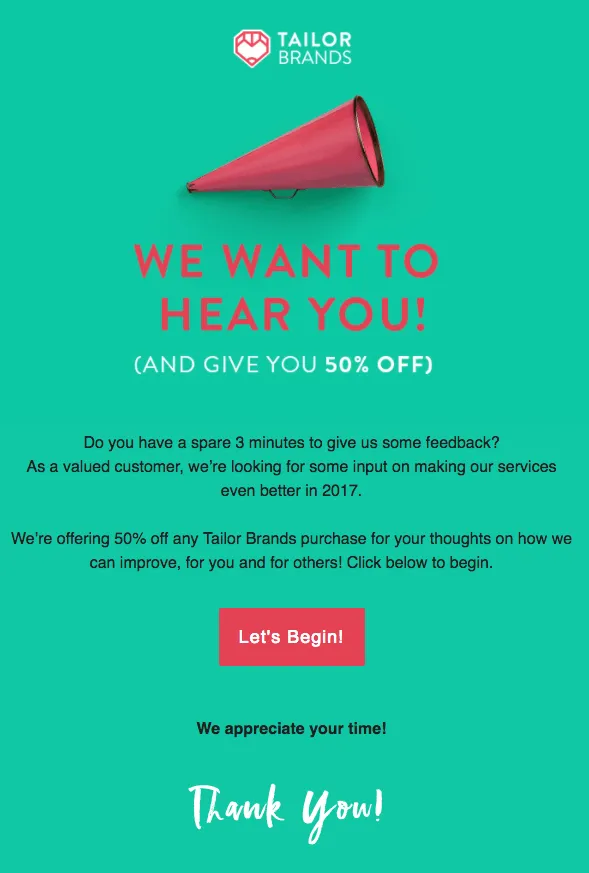
2) Feedback boxes: You’re more likely to receive consistent feedback when it’s easy for customers to provide it. This could be a standing feedback form in the footer of your website, or as a section of the user’s Account page.
3) Focus groups: Enlisting specific customers to provide feedback is a more intensive approach, but gives you a chance to dig deeper. This can be done with one person, or multiple people at a time, but make sure you provide an incentive for volunteering their time.
It’s important to remember that when it comes to asking customers for their opinion, the quality of your answers is largely dependant on the quality of your questions.
According to the Bond Loyalty Report, the top driver of loyalty program satisfaction is that the program “meets needs”. Therefore, the best data you can get is relevant to what needs customers have that you can help address. By understanding their pain points, you can deliver the best solution, instead of offering rewards or opportunities that aren’t more than a nice-to-have.
For example, instead of asking “What reward do you like better?” and giving options of “cash, credit or discounts,'' say instead “What is most important for you to get out of this program?” with answers like “cost savings, time savings, exclusive access, etc”.
From there, you can properly address the need with what is most suitable for your company to be offering.
Establish your audience: Create buyer personas
In our recent post, we talked about how you should leverage your loyalty program’s data to create buyer personas. These are fictional representations of your ideal customers that help you align your marketing efforts to best meet their needs, and attract more users like them.
Creating a buyer persona means establishing the characteristics, demographics, knowledge levels, buying patterns, and pain points of a customer who is most likely to exhibit loyal behavior towards your brand.
By establishing the needs and wants of an ideal customer, you’re better equipped to deliver on them with your loyalty program and its rewards.
It’s all about understanding what customers want from their relationship with your brand, and starts with understanding who you are selling to. Are you selling to individual consumers or to representatives at a large corporation? What motivates this particular individual?
While this doesn’t necessarily count as direct customer feedback, it gives you a better understanding of what motivates the ideal customer to take action.
For more guidance on creating buyer personas, check out this article.
Use your data: Test and iterate
Your loyalty program’s analytics are your source of truth for whether or not your program is meeting customer needs. As they say: the proof is in the pudding.
Monitoring your metrics over time lets you notice trends that may not be apparent from the survey results, since your analytics are an aggregate of everyone’s activity - not just those who provided direct feedback.
For example, your participation and redemption rates are good indicators as to whether you’re offering the right rewards and opportunities for engagement.
Given that customer preference will shift over time, what worked once may not be a viable strategy forever, making it important to monitor your analytics and iterate as necessary.
To learn more about the insights behind your loyalty program’s metrics, check out our article on How to Tell if Your Loyalty Program is Working.
Final Thoughts
Loyalty program success starts with understanding what your customers want, and using your company's resources to deliver on those needs. Don't be shy to ask your customers directly - it's your most valuable source of information.
To learn more about designing a profitable loyalty strategy for any digital business, sign up for the Digital Loyalty Academy for free today!
